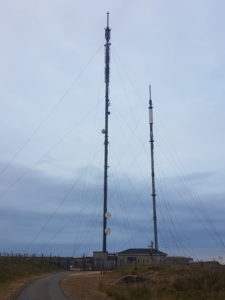The ever-increasing demand for mobile telecommunication, radio, radar, and television communications means that more and more individuals (technical and non-technical) are encountering the telecoms industry. There is therefore the need for a simplified overview/general specification to provide internal and external stakeholders/investors, users, non-technical and technical professionals with the basic knowledge and understanding of telecoms structural engineering.
This post presents the various key classes of telecommunication support structures that are instrumental in the continued success of data transmission.

Self-Supporting Monopole Towers
Monopole towers comprise of constant tapered steel tubes or segmented tubular steel section that are welded or bolted to each other to form a pole decreasing in diameter from the bottom to the top. Sections are usually made from hollow, heavy duty, thick steel tubes, flanged steel tubes or low-alloy, high-strength steel, finished to meet required local aesthetics.

Self-Supporting Lattice Towers
Self-supporting lattice also known as free-standing lattice tower structures consist of truss sections joined to form tapered or straight panel sections. The tapered panel sections have face width that vary according to height and load capacity. Lattice towers can have triangular (tripod) or square (quadpod) footprint. The truss members are commonly hollow tube, equal angle, or solid round bar. Although other section types such as folded (<90deg) steel angle are possible.

Guyed or Stayed Lattice or Monopole Towers
These are lattice or monopole towers similar in design to the self-supporting tower class except that they are further stabilised by tethered wire or rope systems. Guy wires are made from pre-stretched steel only and care must be taken to ensure that they are not be over tightened during installation and in-service to avoid misalignment, cable rupture and permanent wrapping of the tower structural members. Additionally, structural design of the guy anchor shall consider the nature and bearing capacity of the soil.
Roof a nd Wall Elevated Mounts
nd Wall Elevated Mounts
Roof and wall elevated mounts can be an inexpensive way of elevating signals above roof interference or other obstructions by mounting the equipment atop an already high and stable structure (e.g. rooftop of a high-rise building). Roof mounts can be penetrating (impacting) or non-penetrating (non-impacting) installations and can also be self-supporting or guyed. In all cases, structural checks and certification by competent engineering team must be made to establish the capability of the roof to withstand the additional imposed loads due to the proposed ancillaries and steelwork installations.
KA Engineering Group does not only complete structural due diligence for all these telecommunication support structure classes, we also take further responsible steps to consider, advise, and optimise each site, ensuring cost effective installation and maintenance for build contractors and efficient utilisation for operators.
Contact our expert team at: info@ka-engroup.com to learn more and discuss how we can best serve your needs














 nd Wall Elevated Mounts
nd Wall Elevated Mounts